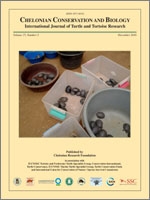Nest-site choice in turtles has a demonstrated impact on their fitness. Previous studies of nest-site choice have focused on environmental factors potentially affecting that choice (e.g., temperature, insolation, soil type, or moisture). Observations of nesting of painted turtles (Chrysemys picta) at the Crescent Lake National Wildlife Refuge in the Nebraska Sandhills suggest that females might use olfactory cues (specifically odors of other nesting females) to choose nest sites. We tested this hypothesis indirectly by using the nearest neighbor (nest) distance algorithm in ArcMap 10.1. Our results for nests in 2012–2014 were mixed, with nesting at some sites, in some years, and by some turtles occurring nonrandomly, in very close proximity to previous nests. Preliminary experimental data from 2015 using urine-treated sites in primary nesting areas also suggested that females showed more interest in those sites than sites moistened with equal amounts of water. These data provide some support for the use of nest odor as an important cue for nest-site choice in turtles, but they are insufficient to reject the possibility of the simultaneous use of other fine-scale environmental cues.
How to translate text using browser tools
1 December 2016
Olfaction as a Cue for Nest-Site Choice in Turtles
John B. Iverson,
Hanna Klondaris,
Christopher S. Angell,
Wendy P. Tori
ACCESS THE FULL ARTICLE
Chrysemys picta
Emydidae
Nebraska
olfaction
Reptilia
Testudines





